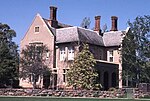National Wine Centre of Australia

The National Wine Centre of Australia (commonly the "Wine Centre") is a public exhibition building about winemaking and its industry in South Australia, opened in 2001. It contains an interactive permanent exhibition of winemaking, introducing visitors to the technology, varieties and styles of wine. It also has a wine tasting area, giving visitors the opportunity to taste and compare wines from different areas of Australia. The Wine Centre is situated at the eastern end of North Terrace, Adelaide in the east parklands and adjacent to the Adelaide Botanic Gardens. The building designed by Cox Grieve Gillett uses building materials to reflect items used in making wine. The exterior of the building looks like a section of a wine barrel. Outside the building are rows of grapevines, showing seven different varieties of grapes to curious visitors who normally would not have access to a vineyard to see the differences for themselves.
Excerpt from the Wikipedia article National Wine Centre of Australia (License: CC BY-SA 3.0, Authors, Images).National Wine Centre of Australia
Botanic Road, Adelaide Adelaide
Geographical coordinates (GPS) Address External links Nearby Places Show on map
Geographical coordinates (GPS)
| Latitude | Longitude |
|---|---|
| N -34.919444444444 ° | E 138.61416666667 ° |
Address
National Wine Centre of Australia
Botanic Road
5000 Adelaide, Adelaide
South Australia, Australia
Open on Google Maps






